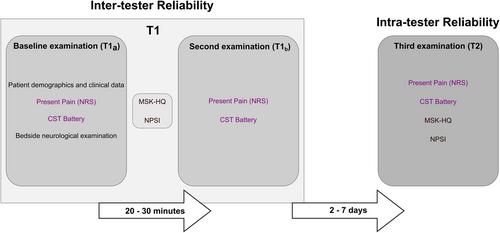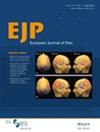Reliability of a clinical sensory test battery in patients with spine-related leg and arm pain
Abstract
Background
The current standard to evaluate the presence of somatosensory dysfunctions is quantitative sensory testing, but its clinical utility remains limited. Low-cost and time-efficient clinical sensory testing (CST) batteries have thus been developed. Recent studies show moderate to substantial reliability in populations with neuropathic pain. This study evaluates the inter- and intra-tester reliability of people with spine-related leg and arm pain, representing mixed pain mechanisms.
Methods
Fifty-three patients with spine-related leg (n = 41) and arm pain (n = 12) attended three CST sessions. The CST battery consisted of eleven tests, determining loss and gain of sensory nerve function. CST was performed by the same investigator twice and by an additional investigator to determine inter- and intra-tester reliability. Fleiss' (inter-tester) and Cohen's (intra-tester) kappa were calculated for dichotomized and intraclass correlation coefficients (ICC) for continuous outcomes.
Results
Fleiss' kappa varied among modalities from fair to substantial (κ = 0.23–0.66). Cold, warm, and vibration detection thresholds and cold and pressure pain thresholds reached kappa >0.4 (moderate to substantial reliability). Cohen's kappa ranged from moderate to substantial (κ = 0.45–0.66). The reliability of the windup ratio was poor (ICC <0.18).
Conclusion
CST modalities with moderate to substantial inter-tester reliability could be of benefit as a screening tool. The moderate to substantial intra-tester reliability for all sensory modalities (except windup ratio) supports their potential use in clinical practice and research to monitor somatosensory changes over time in patients with spine-related limb pain of mixed pain mechanisms.
Significance
We already know that most modalities of clinical sensory test (CST) batteries achieve moderate to substantial inter- and intra-tester reliability in populations with neuropathic pain.
This study evaluates the reliability of a CST battery in populations with mixed pain mechanisms. We found inter-tester reliability varied from poor to substantial for sensory modalities, questioning the value of some CST modalities. The CST battery showed moderate to substantial intra-tester reliability, suggesting its usefulness to monitor sensory changes over time in this cohort.


 求助内容:
求助内容: 应助结果提醒方式:
应助结果提醒方式:


